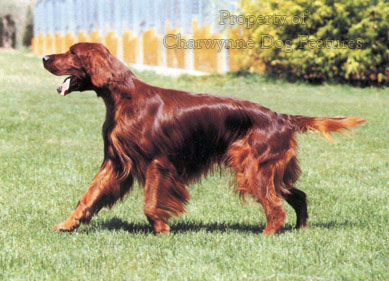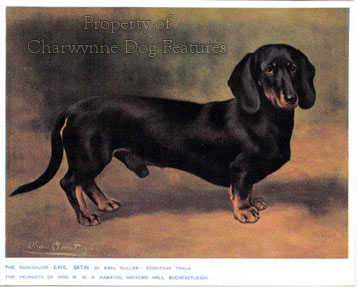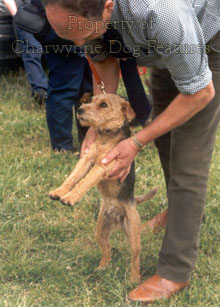206 Bad Breed Standards
BREED STANDARD WORDAGE: THE BARAGOUIN IN THE BLUEPRINT
by David Hancock
 The apparent astonishment of Breton soldiers on seeing white bread for the first time allegedly gave our wonderfully adaptive language a new word: 'baragouin', meaning unintelligible words or phrases. Engineers gave us the word 'blueprint', meaning the graphic illustration of the final stage of a plan. Breed standards for pedigree dogs are often described as the blueprint of a breed, the written description of what the final article should look like. A drawing or graphic illustration of a finished product makes it easily visualised; a description in words alone can become wide open for both innocent and mischievous misinterpretation. It is a sad fact that many breeds of pedigree dog have a written KC-approved standard which can fairly be described as a baragouin.
The apparent astonishment of Breton soldiers on seeing white bread for the first time allegedly gave our wonderfully adaptive language a new word: 'baragouin', meaning unintelligible words or phrases. Engineers gave us the word 'blueprint', meaning the graphic illustration of the final stage of a plan. Breed standards for pedigree dogs are often described as the blueprint of a breed, the written description of what the final article should look like. A drawing or graphic illustration of a finished product makes it easily visualised; a description in words alone can become wide open for both innocent and mischievous misinterpretation. It is a sad fact that many breeds of pedigree dog have a written KC-approved standard which can fairly be described as a baragouin.
Is it any wonder then that the subject when seen falls short of what the eye is expecting? Is it at all surprising that fanciers preferring their own stock interpret the words to suit themselves? It is surely vitally important for the wording of a breed standard to mean the same to every reader, without ambiguity or scope for false interpretation. And how can the Kennel Club authorise the foolish or totally inadequate use of words? The one word "long" will never be enough to describe the bloodhound's neck for the novice breeder. The one word "racy" to cover the Border terrier's hindquarters will hardly give a novice judge much to go on; Jilly Cooper's novels have been described as racy!
Is it wise for the chest of an Irish setter to be "as deep as possible"? Why on earth does the Cavalier King Charles spaniel have to be "absolutely fearless" or the Dachshund "courageous to the point of rashness" ? Not even the bullterrier, a purpose-bred gladiator has to meet that stipulation. But of what value is such inappropriate phraseology? The Border terrier is required to possess the characteristic : "Capable of following a horse". Where? a non-hunting breed enthusiast could be forgiven for asking. I suspect the phrase needed is "able to run with the hounds" i.e. not carried in a mounted terrier man's pouch.
Some phrases, regularly used in breed descriptions, are repeatedly misunderstood; one such being "standing over a lot of ground". The bloodhound is expected to stand "over more ground than is usual with hounds of other breeds". Does this mean more than the greyhound, which has to be constructed so as to enable "adequate ground to be covered when standing"? Does therefore a 26" bloodhound have to "stand over more ground" than a 28" greyhound? for that is the implication.
Exhibitors in some breeds seem to think that "standing over a lot of ground" means a need for them to position their dog's hind feet way way back from beneath its hip joint, which can only be bad for the dog's spine and if natural, a sign of incorrect conformation. But according to the Kennel Club's glossary of terms "covering ground" is the amount of ground covered by a dog when moving or standing. So the phrase can officially mean two totally different things; that's a fat lot of use to a novice judge!
The use of meaningless and therefore valueless words should be avoided in any blueprint. Take the imprecise word 'moderate', for example. It conveys no clear guidance whatsoever, yet features in most breed standards. Look, for instance, at the standards for the Australian breeds: the Australian terrier has to have a nose 'of moderate size'; the Australian Silky be 'moderately low set' in general appearance, with head and skull of 'moderate length' and be 'moderately broad between the ears'; the Australian cattle dog has to have a 'moderately broad' chest and the Australian shepherd a neck which is 'moderate in length'. But what does a judge or breeder deduce from the use of this word in each of these standards? What if an Australian cattle dog displays, in the ring, an immoderately broad chest? The phrase would defy definition. The word 'moderate' crops up five times in the field spaniel's and four times in the Belgian shepherd dog's breed standard, each time unhelpfully.
The field spaniel is expected to display "moderately well sprung ribs", but the KC definition of well sprung ribs is "ribs springing out from spinal column giving correct shape". What 'correct' shape is desired? a novice judge could enquire. The English springer spaniel has to have well sprung ribs, as do the Clumber, Cocker and Welsh springer spaniels. Why of all the sporting spaniels does the field's ribs have to be moderately well sprung? Does it have any significance?
The breed standard of another sporting spaniel, the American cocker, is defied each time one goes into the ring. First of all, the breed has to be "serviceable looking". The ones I see are anything but serviceable, being so profusely coated as to be unuseable in the field. This standard goes on to state that the legs "must be well feathered but not so excessive as to hide body lines or impede movement and function as a sporting dog". Every American cocker that I see in the show ring disobeys these words. What is the point of a breed standard if exhibitors and then judges totally disregard it? Who is in authority, anyone at all?
At their AGM on the 24th of May, 1994, the Kennel Club received the chairman's report which stated: "The most important work of the (breed standards') Committee this year has been the reprint of the breed standards in loose leaf format..." Sounds more like the annual report of an underemployed printer! The most important work of this particular committee of the Kennel Club in any year can only ever be : to produce a written blueprint for each recognised breed which conveys to the reader a clear indication of what that breed should look like, together with some guidance on essential breed characteristics and desired temperament. That, if the words are chosen wisely, should produce in time standardisation in the ring, rather than a parade of the output from the latest whim of the breed club's dominant clique. 
If the Kennel Club approves these standards and owns their copyright, then they the Kennel Club must also accept full and unreserved responsibility for the wording which they authorise. It would be a different matter if the respective breed council "owned" their own standard, but they do not. Authority is inextricably linked to responsibility. A club can set up as many committees or sub-committees as it likes; the responsibility remains centrally. I cannot think of one breed standard which doesn't urgently need a severe overhaul. Even the format is abused.
A poorly worded "general appearance" rather insults a breed; its "characteristics" should be absolutely vital to the breed's identity and the words under "temperament" never neglected. But do we find that? Time and time again in breed standards, temperament is confused with characteristics (and vice versa). The words on temperament should tell us what kind of temper the dog has, how it is inclined to act or react -- its natural tendency to behave. Its characteristics should indicate what makes the breed distinctive, its essential features or pecularities -- the aggregate of idiosyncrasies which make up its identity as a particular breed.
But now look for example at the "characteristics" under the breed standard of the Weimaraner, which states just this: "Hunting ability of paramount concern". Does that do justice to such a truly distinctive breed? Do those words not apply to any gundog or hound breed? The golden retriever's characteristics are listed as: "Biddable, intelligent and possessing natural working ability". Tell me of a gundog which shouldn't have those attributes. What makes this lovely breed special ? No breed club can surely be happy with such banality.
It is the Kennel Club's intention that each breed standard shall be a description of the ideal specimen in each breed. In this way, the show ring judge can look out for breed points, rather than judge every breed to one common standard. If you are breeding and showing pedigree dogs to a breed blueprint, then the words used immediately assume enormous importance. It is rather lame to complain when dogs in the ring do not conform to a breed standard if that breed standard isn't worth the paper it's written on.
Far too many breed standards are being ignored; most are badly worded; many are poorly constructed and few produce the crystal-clear meaning so vital for competent judging and sound breeding programmes. Far too many breed clubs seem content with words which do scant justice to the fine breeds they represent and claim to cherish. There is now a more than pressing need for the Kennel Club committee responsible for breed standards to concentrate less on ease of amendment and more on validity. 
I have heard it argued that the KC as custodians of the standards see it as their duty to resist changes from breed clubs, on behalf of their members, to suit a contemporary desire. But this argument does not withstand even a cursory examination. Look at the standard of the golden retriever. Sixty years ago the required colour of the coat was laid down as: "Rich, golden, must not be...cream colour". But some breeders could not manage this. The desired colour now is "Any shade of gold or cream". So much for principles! Look too at the standard of the bullterrier on the subject of eyes. Nowadays they are required to "appear narrow", but this was not the case when this breed standard was first written by the most knowledgeable bullterrier breeders in the world.
The Kennel Club-authorised breed standards for our distinguished breeds of pedigree dogs are in a mess. They can be amended to suit the breeders of a particular period -- as the last paragraph demonstrates. They are confusingly worded, mean different things to different people, are consistently ignored in the show ring and do scant justice to the superb qualities of their subjects. Our world famous breeds deserve better than this. If the blueprint isn't right -- well, ask any engineer or architect what the result is, usually a functional disaster. This is a simply vital aspect of the dog breeding and showing world. It is quite clearly one receiving not just inadequate attention but a distinct lack of both drafting quality and authoritative direction. We want less barguignage on this subject -- and definitely no more baragouin. Someone "in authority" at the Kennel Club clearly needs a kick!